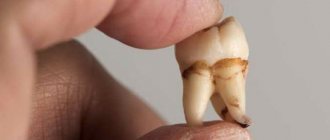Author of the article:
Soldatova Lyudmila Nikolaevna
Candidate of Medical Sciences, Professor of the Department of Clinical Dentistry of the St. Petersburg Medical and Social Institute, Chief Physician of the Alfa-Dent Dental Clinic, St. Petersburg
Expecting relief from pain from going to the dentist, patients sometimes leave the office confused - why hasn’t the pain completely gone away? It can be present for several hours or last much longer.
Diagnosis and treatment
Diagnosis of increased tooth sensitivity after installation of a filling includes:
- probing,
- electroodontometry.
Based on the results of the examination and examination, the doctor chooses treatment tactics.
- Fluoridation of teeth. Reduces sensitivity and enriches enamel with beneficial substances.
- Use of desensitizing paste and fluoride-containing rinses for oral care. With regular use of such products, teeth become less sensitive.
If the cause of hyperesthesia is non-compliance with filling rules, and the problem cannot be solved by conservative methods, repeated dental treatment is performed.
Why does a tooth hurt after caries treatment?
The pain reaction depends not only on the professionalism of the doctor, but also on the individual characteristics of the human body, its pain sensitivity threshold.
Caries is the most common disease for which people consult a dentist.
It happens that after treatment, pain may occur when biting, tooth sensitivity, and soreness of the gums may appear.
What could cause this?
- If the treatment was using local anesthesia, which was carried out directly near the tooth, then naturally the gums may react, because Anesthesia is an injection, therefore there is a small wound that heals over a certain period of time. (prick your finger, it will also hurt for a while).
- When treating superficial and medium-sized caries, sometimes there is increased sensitivity of the enamel, which is manifested by sharp tingling sensations in the tooth. Such sensations usually occur after exposure to a certain irritant (cold, hot, sour, sweet). The fact is that in the process of treating caries and further placement of fillings, they are made as follows called etching of the enamel with a special agent, which is then washed off and the surface is dried. If the dentin is dried too much, the dentinal tubes of which it consists lose internal moisture, which leads to pain. Usually these phenomena disappear within 1-2 weeks. During this time, the overdried tissues are filled with moisture again and the sensitivity goes away. If symptoms continue, you should contact your dentist.
- Pain can also occur due to under-drying of the tooth. In this case, the tooth reacts when you press and bite on it. And the point is this: after etching the enamel, a special adhesive is used to ensure good fixation of the filling, which penetrates into the dentinal tubules. After which the filling material is applied, which is then illuminated with a lamp. And in a place where there was excess moisture and an uneven adhesive layer was created, the seal comes off. And during the chewing process, i.e. When pressing on a tooth, pain appears.
- If your tooth hurts after treatment of deep caries, do not worry. This is a normal tooth reaction. It should be remembered that in this case the pain can last up to several days. It gradually decreases and then goes away completely. This is due to the fact that the carious cavity comes very close to the dental pulp (neurovascular bundle) and all manipulations during tooth treatment in this case have an irritating effect. Over time, the pulp builds a “roof” over itself from new dentin - it hides, and the painful sensations gradually stop. But if the tooth still hurts even after 2 weeks, you need to consult a dentist. Perhaps complicated caries – pulpitis (nerve inflammation) – is already taking place here.
Toothache after filling therapy
If caries has destroyed part of the tooth structure, this part must be completely removed (clean out the carious cavity) and filled. However, in the case of deep caries or carious lesions in the area between the teeth, it cannot be ruled out that not everything will be detected and removed (in cases of poor quality treatment). Then the filling can cause and even worsen toothache. Even if the decay is completely removed, a deep filling can irritate the dental nerve and cause toothache.
A patient experiencing discomfort should immediately report toothache to their dentist. The dentist can, by conducting an X-ray examination of the affected tooth, more accurately determine the cause of the pain and respond accordingly. For example, if the tooth's nerve is irritated, the filling is removed and an antibiotic is injected into the tooth before the filling is placed again. Such manipulations will help contain the onset of inflammation and reduce pain.
What does a doctor do
Pain in the area of the treated tooth is a consequence of the fact that caries, pulpitis or periodontitis develops under the filling.
The first thing the doctor will do is take a picture of the diseased tooth. The picture can be taken using an X-ray machine or an ultrasound machine. The second is more preferable because it is less harmful.
Once the cause is clear, the doctor will open the filling and carry out the necessary treatment. Sometimes the dentist may prescribe antihistamines and also prescribe a course of anti-inflammatory medication.
Precautions to reduce tooth sensitivity during rehabilitation
After caries treatment, the patient needs to follow simple precautions that will help quickly restore normal reactions:
- Use desensitizing toothpastes containing high doses of fluoride, potassium chloride, potassium nitrate or other remineralizing elements to help reduce tooth sensitivity. Pastes with abrasive particles are prohibited at this time.
- During the rehabilitation period, toothbrushes should be used with medium or low bristle stiffness; the front teeth should be brushed with strictly progressive movements up and down, and chewing teeth should be brushed with circular movements clockwise.
- Foods high in vitamin D (milk, fish, egg yolk, cheese, liver) should be added to your diet to further strengthen tooth enamel.
- To rinse the cavity, you can use various formulations, for example, tea tree oil (3 drops per glass of water). It has high antibacterial properties, prevents the development of caries, and eliminates unpleasant odors.
- The simultaneous consumption of cold and hot foods is not recommended; overly sour or sweet foods, as well as coloring foods, should be avoided. After every meal you need to rinse your mouth.
If sensitive teeth still cause significant discomfort, you can take non-steroidal anti-inflammatory drugs - consult your dentist.
Increased sensitivity of teeth during deep stages of caries
Caries develops gradually - at first, a person may not even suspect that he has this problem if he does not practice regular dental examinations. There are four stages of the carious process:
- the so-called “chalk stain”, when the enamel changes color and acquires a darker shade - grayish or milky;
- superficial: teeth begin to react to hot, cold, sour, etc., the stain becomes rough;
- medium caries, when carious cavities increasingly destroy dentin, and pain occurs more often and is felt more strongly;
- deep: the carious process begins to affect the pulp, a cavity is formed bordering the dental nerve.
If caries is not treated, its complications are inevitable, for example, pulpitis, periodontitis, and as a result, teeth can simply be lost.
Causes of tooth sensitivity
- development of caries - in this case, the localization of the problem occurs only in those teeth that are susceptible to the carious inflammatory process,
- violation of the mineral composition of tooth enamel due to a lack of vitamins in the body, especially calcium, fluoride or vitamin D, excessive smoking,
- mechanical damage to the enamel: for example, due to excessive brushing of teeth (more than 2 times a day), using a brush with hard bristles, too much pressure on the teeth,
- gradual erosion of tooth enamel and exposure of the inner layer of teeth,
- recent whitening or scaling procedure,
- gum recession due to periodontitis or periodontal disease, when tooth roots are exposed - in such a situation, increased sensitivity occurs in this area,
- severe infectious diseases, neuropsychiatric disorders, as well as endocrine system disorders,
- pregnancy or menopause in women.
Possible causes of toothache after treatment
Tooth and gum pain are important warning signs of disease or injury that requires treatment. Often, symptoms disappear completely when the dentist removes the existing decay and gives the tooth a filling or denture (such as a crown). To prevent tooth preparation from causing pain to the patient, a local anesthetic is usually injected into the surrounding gums, the effect of which wears off completely after a few hours.
Temporary pain immediately after treatment is often harmless.
If pain occurs immediately after the anesthetic has subsided, it is a simple reaction to the procedure and usually goes away within a day. The puncture site of the syringe can also be painful because the anesthetic is applied to the soft tissue with pressure and can cause pain, which, however, also passes quickly. If the pain persists for a longer period of time or even worsens, it is recommended to visit the dentist again to find out the cause and take countermeasures if necessary.
What helps with toothache after dental treatment?
In any case, you should visit your dentist and discuss the problem together. Depending on the specific situation, he can decide whether a new tooth filling is necessary (possibly with a different filling material) or whether a crown should be installed instead, which, however, usually requires re-preparing the tooth and entails additional costs.
Taking painkillers with paracetamol or ibuprofen helps with acute pain that has no apparent cause. Patients should ask their dentist about a suitable medication immediately after treatment and take it in cases of toothache.
In case of swelling that occurs after root canal treatment, it is necessary to cool the affected area from the outside. A cold compress or wet gauze chilled in the refrigerator can relieve pain and help reduce swelling more quickly. However, a strong cold irritant can also aggravate toothache, especially with deep fillings; in addition, the sensitive dental nerve can be irritated.
Much safer are proven home remedies, such as chamomile or mint tea, which are used to thoroughly rinse the affected areas. Clove or tea tree oil has an analgesic and disinfectant effect and can relieve pain.
But, in any case, it is important to understand the cause of pain and not self-medicate without the advice of a specialist. If you have any concerns or discomfort, you should immediately seek advice from a professional dentist. Call APOLLONIA Dental Clinic and we will help solve any of your dental problems.
Root canal treatment as a cause of toothache
Root canal treatment is always necessary when the dental nerve is affected or completely dead (pulpitis). In this case, the dentist “opens” the tooth with a drill and exposes the root canal system. Then the dental nerve and possible bacterial deposits inside are removed mechanically, the root canals are washed with an antibiotic, and then the cavities are closed with a suitable filler.
These root fillings may cause pain when squeezed, especially in the first few days after treatment, as the filling and treatment can irritate and sensitize the surrounding nerve tissue in the gums. Minor swelling may also occur. However, symptoms usually go away on their own after a few days. If they persist for more than a week or become significantly worse, you should contact your dentist immediately.









